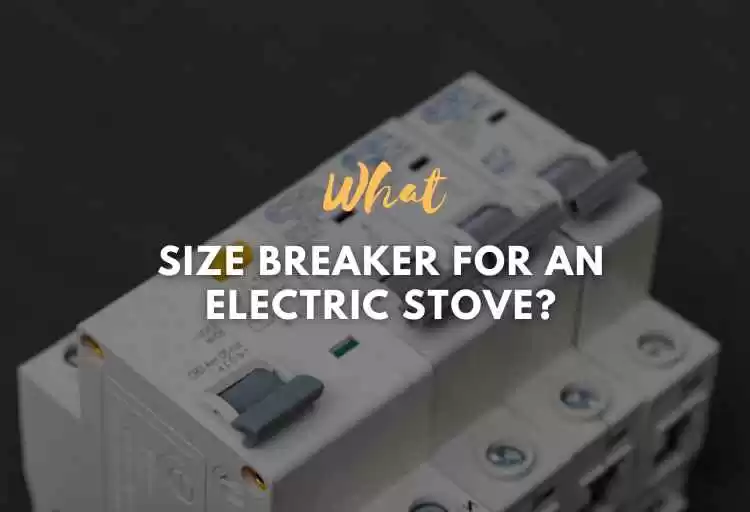What Size Breaker for an Electric Stove?
Electric stoves are a common appliance in many households, providing a convenient way to cook and bake food. However, when it comes to installing an electric stove, it’s important to make sure that the electrical circuit is properly sized to handle the load.
What Size Breaker for an Electric Stove? The appropriate size breaker for an electric stove depends on its power requirements. Typically, a residential electric stove with a 240-volt power rating would require a 40-50 amp breaker. Commercial stoves may necessitate higher amperage. Always consult the stove’s manual or a licensed electrician for precise breaker sizing to ensure safety and compliance with electrical codes.
In this article, I’ll discuss what size breaker is needed for an electric stove, and provide some tips for ensuring that your stove is properly installed.

Contents
What Size Breaker for an Electric Stove?
The size of the breaker required for an electric stove is determined by the stove’s power requirements and the electrical circuit it will be connected to. Electric stoves commonly come in two voltage ratings: 240 volts and 208 volts. The standard voltage for most residential electric stoves is 240 volts.
Voltage Rating:
A 240-volt electric stove requires a dedicated circuit with a double-pole breaker. This means that both hot wires (each carrying 120 volts) from the circuit panel connect to the stove to provide a total of 240 volts.
Current (Amperage) Rating:
The amperage rating of the breaker is determined by the stove’s power consumption, usually measured in watts or kilowatts. To find the amperage, divide the power rating of the stove by the voltage it operates on. For instance, if a stove consumes 9600 watts on a 240-volt circuit, the amperage required would be 9600 watts / 240 volts = 40 amperes.
Circuit Protection:
The breaker’s role is to protect the electrical circuit and wiring from overheating due to an overload or short circuit. The breaker’s amperage rating should be equal to or slightly higher than the stove’s calculated amperage.
In most cases, a 40-50 amp double-pole breaker would be appropriate for a residential 240-volt electric stove. For a 208-volt stove, a slightly higher amperage may be needed due to the lower voltage.
Electrical Codes and Safety:
It is crucial to follow electrical codes and regulations when installing a circuit and breaker for an electric stove. The National Electrical Code (NEC) and local building codes specify the requirements for circuit sizing, wire gauge, and other safety considerations.
To ensure proper installation and safety, it is recommended to consult a licensed electrician who can assess the specific requirements of the stove, and the existing electrical system, and adhere to the applicable codes.
Determining the Size of the Circuit
The size of the circuit needed for an electric stove depends on the stove’s wattage and the distance between the stove and the circuit breaker. The wattage of the stove can usually be found on a label on the back of the stove, or in the owner’s manual. The distance between the stove and the circuit breaker is the length of the wire that connects the two.
To determine the size of the circuit needed for your electric stove, you’ll need to do some calculations. The first step is to determine the stove’s wattage. For example, if your stove is rated at 6,000 watts, you’ll need to divide that by the voltage of your electrical system (usually 240 volts in the United States) to get the amperage. In this case, 6,000 watts divided by 240 volts equals 25 amps.
Once you know the amperage, you’ll need to factor in the distance between the stove and the circuit breaker. This is because the resistance of the wire increases as the length of the wire increases, which can cause the voltage to drop. To compensate for this, you’ll need to use a larger wire gauge and a larger circuit breaker.
Choosing the Right Wire Gauge
The wire gauge is a measure of the size of the wire, with smaller numbers representing thicker wires. For an electric stove, you’ll need to use a wire gauge that can handle the amperage of the stove, as well as the distance between the stove and the circuit breaker.
The most common wire gauges for electric stoves are 8-gauge and 6-gauge. An 8-gauge wire can handle up to 40 amps, while a 6-gauge wire can handle up to 55 amps. To determine which wire gauge to use, you’ll need to factor in the amperage of the stove and the distance between the stove and the circuit breaker.
For example, if your stove requires a 25-amp circuit and is located 50 feet away from the circuit breaker, you’ll need to use a 6-gauge wire. This is because the resistance of the wire will cause the voltage to drop, and a larger wire gauge will help compensate for this.
Choosing the Right Circuit Breaker
Once you’ve determined the wire gauge needed for your electric stove, you’ll need to choose the right circuit breaker. The circuit breaker is designed to protect the electrical circuit from overloading and is sized based on the amperage of the stove and the wire gauge.
For an electric stove, you’ll need to use a circuit breaker that can handle the amperage of the stove, as well as the wire gauge. The most common circuit breaker sizes for electric stoves are 40 amps and 50 amps.
To determine which circuit breaker to use, you’ll need to factor in the amperage of the stove and the wire gauge. For example, if your stove requires a 25-amp circuit and you’re using a 6-gauge wire, you’ll need to use a 40-amp circuit breaker.
Tips for Properly Installing an Electric Stove
Installing an electric stove requires more than just choosing the right wire gauge and circuit breaker. Here are some tips for ensuring that your stove is properly installed:
- Hire a licensed electrician: Unless you’re a licensed electrician, it’s best to hire a professional to install your electric stove. They’ll be able to ensure that the electrical circuit is properly sized and installed and that all safety precautions are taken.
- Check local building codes: Before installing your electric stove, be sure to check local building codes to ensure that you’re in compliance. Some areas may have specific requirements for electrical circuits and installations.
- Use the right outlet: Electric stoves require a special outlet that is designed to handle the high amperage. Make sure that the outlet you’re using is rated for the amperage of your stove.
- Use the right wire: When installing the electrical circuit for your electric stove, be sure to use the right type of wire. Copper wire is the most common type of wire used for electrical circuits, but there are also aluminum and copper-clad aluminum wires available.
- Don’t overload the circuit: To avoid overloading the electrical circuit, make sure that you’re not using other high-amperage appliances on the same circuit as your electric stove.
Conclusion
Choosing the right size breaker for an electric stove is essential for ensuring that your stove operates safely and efficiently. To determine the size of the circuit needed for your stove, you’ll need to calculate the amperage and factor in the distance between the stove and the circuit breaker.
You’ll also need to choose the right wire gauge and circuit breaker and take other safety precautions when installing your electric stove. By following these tips, you can ensure that your electric stove is properly installed and ready to use.



